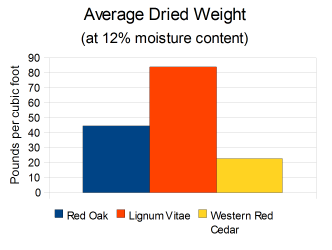Average Dried Weight
This is a measure of a wood’s weight in relation to a preset volume. Usually, it’s pounds per cubic foot (lbs/ft3), or in metric units: kilograms per cubic meter (kg/m3). However, a wood’s weight will also greatly depend on its moisture content (MC). For instance, a board that has just been freshly cut (called “green” wood) can weight more than double its oven-dry weight! Since there are so many sources of information on wood properties, and not all of them use the same standards and testing procedures, there can be a great variety in weight readings.
I’ve made every effort to standardize all readings to reflect the weight at a 12% moisture content; this is the most common standard of measurement for nearly all wood testing conducted worldwide. The moisture content of 12% is attained when a wood sample has reached equilibrium moisture content (EMC) with the surrounding air at a temperature of 70°F and relative humidity of approximately 65%. Storing wood in areas where the relative humidity is lower than this will result in A lower moisture content, and therefore a correspondingly lower density.

Take time to compare a density reading to another well-known wood, and see how it measures up. For instance Red Oak is about 45 pounds per cubic foot, (or 730 kilograms per cubic meter), which in and of itself isn’t too terribly useful, seeing as how you will most likely never encounter (or be required to lift) a piece of oak that is a perfect one-foot (or one-meter) cube. However, if you make a mental note of this weight, and use it to gauge other woods, you can quickly get an idea of how much things weigh. (For example, you can quickly see that Western Red Cedar weighs about half as much as Red Oak, but Lignum Vitae’s weight is almost double that of Red Oak!)
Additionally, in general terms, a wood’s density can be used to deduce a number of things about a wood’s properties; i.e., hardness, strength, etc. The heavier wood is, the harder and stronger it is, in general.